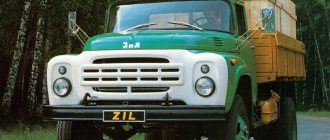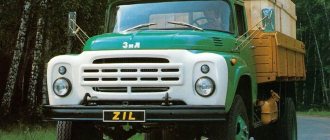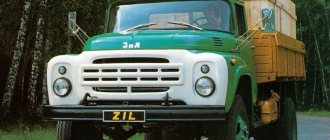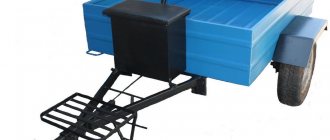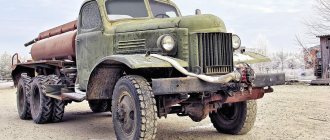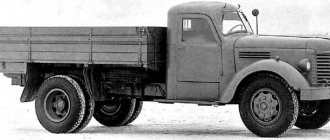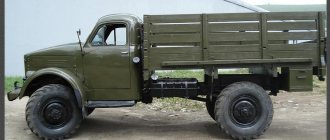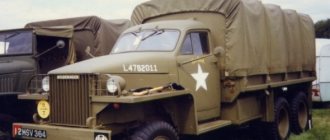We can talk about the legendary ZIL 130th model for hours. It all started in the post-war years, when the Soviet Union needed equipment for agricultural needs. This Soviet, and later Russian car, replaced the old ZIL-164 model, which was initially produced as the ZIS-150. Before the model became what we know it to be, quite a few changes were made to it. Before the restructuring of the Stalin plant, the model was produced as the ZIS-125.
As a product of the Likhachev plant, it was produced from 1962 to 2010. Initially, assembly was carried out in Moscow, but in the 90s the facilities were moved to Novouralsk. There the car was produced under a different name, Amur. It is noteworthy that the ZIL-130 became the first truck of its kind to be painted white and blue. Before this, all ZILs were painted khaki, since they were created for military purposes. The entire ZIL model range.
Appearance
The foreshadowing versions of ZIL trucks were extremely unfinished and crude. The justification is compelling; a large amount of equipment was required to repair damage after the war. But in the end, already in 1956, prototypes were significantly more beautiful than their predecessors.
After a number of regular changes, which concerned both the restyling of the truck and the plant itself, the ZIL-130 was presented at the annual international fair in Leipzig, where it received a gold medal, and the engineers received many diplomas. Since that time, the “130” model began to gain unprecedented popularity.
The fact is that ZIL dump trucks had quite a lot of modifications. The most commonly used of these were semi-trailers and articulated dump trucks. The most significant modifications were made in 1966 and 1977. On the basis of the usual “one hundred and thirty”, fire engines and truck cranes, tank trucks and vans, flatbed vehicles and construction dump trucks were created.
The car is efficient even in cramped urban environments thanks to its turning radius of up to 7 meters. Having a carrying capacity of only 3 tons, the ZIL-130 itself weighs at least 4 tons. At the same time, it can be used to tow a trailer weighing no more than 8 tons. From the outside, the Russian truck looked very good for that time. The car was capable of attracting attention.
It was painted white and blue. Before the ZIL-130, all automobile enterprises worked only for the defense and army spectrum, based on this, the car had a protective paint. The hood was alligator style. ZIL received streamlined wings and a panoramic windshield. In addition, the cabin was equipped with a ventilation hatch and windows.
Body
The body was supplied with a folding tailgate and was considered a cargo-passenger one. The gratings located on the sides were equipped with benches that could be folded back. They could fit 16 people. There was also a bench that could be removed - it could seat 8 people.
The basic modification of the ZIL-130 includes an awning along with arches, which can be removed and installed at any time. The body design is also practical. The height of the floor of the cargo compartment of the ZIL-130 is similar to the height of the floor in railway cars. This fact greatly simplifies the loading and unloading process.
Additional equipment included blackout for military versions, canisters, an ax, and a shovel.
STORY
In the mid-1950s, the growth rate of industry and agriculture in the USSR accelerated noticeably. The ZIS 150, developed in the pre-war period, could no longer meet the increased needs due to the obsolescence of the design. ZIL 164, which appeared in 1957, became a temporary solution and did not completely solve the problem, since it was a deep modernization of the ZIS 150. The country needed a fundamentally new car. Product development took place in a short time; prototypes of the ZIL 130 appeared already in 1956. As a power plant, the 4-ton vehicle received a ZIL-120 unit, inherited from the previous model. This measure was temporary; soon an 8-cylinder 150-horsepower unit became the main engine. Testing and refinement of the model took 6 years; pilot batches of the ZIL 130 were released only in 1962. However, even after this, the car did not make it into the series; additional testing took another 2 years. Full production of the new model opened in October 1964.
The appearance of the ZIL 130 was a landmark event for the Soviet automobile industry. Domestic drivers received a model that surpassed all existing cars in terms of comfort. A 5-speed transmission with synchronizers for all gears (except first) and power steering significantly simplified control. The car started from a stop in second gear, and first gear was used only for steep climbs and off-road.
The design of the ZIL 130 was also innovative. The exterior of the truck was designed by Eric Szabo. The young specialist created a completely new image with stylish cabin contours, panoramic glass and an embossed radiator grille. The car received a hood layout in the American style. There was nothing like this among cargo models at that time.
The color of the car has also changed. If earlier cars were painted khaki for quick mobilization during the war, now sky blue has become the main color. The front of the ZIL 130 was made white. There were other colors (dark green, yellow), but it was sky blue that became the main one.
The model quickly gained consumer interest. In addition to beauty, the car had rich functionality and reliability. Before the overhaul, the ZIL 130 traveled 300,000 km, and its carrying capacity was 5 tons.
The successful design played a cruel joke on the car. For a long time since its appearance, there have been no changes in the design of the car. At the Likhachev plant they were engaged in the creation of cabover trucks, and practically no attention was paid to the modernization of the ZIL 130. Only in 1966 did the manufacturer think about improving the design of the model, which by that time was already seriously outdated. It was then that the first update of the series appeared. However, there were no major changes in the design of the model.
In 1978, production of the modernized ZIL 130-76 began, which differed in appearance from the original version in a modified “front end” (the headlights and sidelights were swapped).
In 1986, the series was updated again. The car was named ZIL 431410, but in terms of construction and design it turned out to be an almost complete copy of its predecessor. The main disadvantage of the car was the gasoline unit with low efficiency and environmental friendliness. The manufacturer developed the diesel engine independently, and the first ZIL 130 models with it appeared only in 1987. At the same time, most modifications continued to install the old gasoline engine.
Production of the series at the Likhachev plant was finally completed in 1994. The car was produced at the Ural Automotive Plant until 2010.
Cabin interior
The steering mechanism of the ZIL-130 was a screw with a special spherical nut plus a piston-rack. The hydraulic booster was built-in. The three-seater cabin is located immediately behind the engine. The seat is adjustable in length, height and backrest tilt. The main options in the cabin included a heater, a windshield wiper with two blades, and a glass washer. For the 60s, the cabin ergonomics are at the highest level. The instrument panel and functional instruments are located very conveniently for the driver.
The designers provided two ventilation hatches in the cabin roof. The radiator grille has become a memorable element. The cabin was made of solid metal and had three seats. The engineering staff did a great job, because the car was comfortable and was very different from many Soviet trucks. Drivers received improved conditions for performing their work.
It was much more comfortable to sit inside, because the changes also affected the width - it was increased by 1.2 meters when compared with the ZIL-164 model. Instruments and controls were optimally located in the spacious cabin. In addition, soft seats appeared - for the driver and for passengers (double). The driver's seat could now be adjusted in horizontal and vertical directions.
It was also possible to change the angle of the chair back and pillows. It was on the ZIL-130 that the hydraulic power steering wheel debuted. Thanks to this, not only the ease of driving the truck increased, but also its safety - if the front wheel broke, it was easier to keep the truck on the road.
ENGINE
The first versions of the ZIL 130 were equipped with a 6-cylinder carburetor engine with a V-shaped design. The 5.2-liter engine had a power of 135 hp. But testing showed that the functionality of the unit was not enough to perform tasks of increased complexity, so work began on modernizing the power plant.
The base for the ZIL 130 was the 4-stroke carburetor overhead valve engine ZIL-130. 8 cylinders in the design of the unit were located at a 90-degree angle. The cylinder block was made of cast iron and had heads and pistons made of aluminum alloy. The power system used the technology of forced fuel supply through a B-10 fuel pump with a lever allowing manual pumping of gasoline, and a K-88 two-chamber carburetor. The liquid closed cooling system had forced circulation. A standard solid-fill thermostat was used to control the temperature.
Characteristics of the ZIL-130 engine:
- working volume – 5.969 l;
- rated power - 150 hp;
- maximum torque – 402 Nm;
- compression ratio – 6.5;
- number of cylinders – 8;
- cylinder diameter – 100 mm;
- Recommended fuel type is A-76 gasoline.
Since 1974, the ZIL 130 began to be equipped with a 6-cylinder ZIL 157 engine with an in-line design and a power of 110 hp. An economizer has been added to the engine design. Forced replenishment was provided by a fuel pump. There were no global changes in the parameters of the unit; it continued to operate on A-72 gasoline, and fuel consumption decreased slightly.
For the latest modifications and export versions of the ZIL 130, diesel units were also available.
Specifications
The ZIL-130 car was initially equipped with an eight-cylinder 4-stroke engine with a capacity of 148 horsepower (3000 rpm). The working volume reached 6 liters. The engine lubrication system was combined, with splash and pressure. The engine power supply system is forced, the cooling system is liquid.
The suspension was dependent, the frame consisted of steel spars with five cross members. Starter 1.5 hp turned on via a traction relay. Known to everyone, the ZIL-130 truck became a breakthrough in Soviet mechanical engineering. Along with it, three-seater cabins, a hydraulic power steering wheel, a gearbox that included helical gears and synchronizers, an engine pre-heater, glass washers and more appeared.
Power unit
ZIL-130 acquired a power unit, the design of which had much in common with the motor from the ZIL-111 modification. It was a V-shaped eight-cylinder engine, but with a smaller displacement, which was designed for 76 gasoline, which was already familiar at that time. The engine came with a 2-chamber K-88AE carburetor, with a falling flow, and a balanced float chamber. There was a rev limiter.
From the very beginning, an experimental type engine was proposed, which was carburetor and had a V-shaped cylinder arrangement. The volume was 5.2 liters. Such an engine was capable of developing up to 135 horsepower and 3200 rpm. The camber of the cylinder block was 90 degrees. However, during the debut tests it became clear that such power would not be enough and the ZIL-130 truck simply would not be able to achieve good dynamics.
Then work began on using 8 cylinders in the same V-shape. Such improvements made it possible to increase engine power to 150 horses. It was then that the decision was made to curtail the production of 6-cylinder units. The new engine allowed the car to reach speeds of up to 90 km/h. The valve position on this 4-stroke engine was at the top. The engine capacity was 6.0 liters and 3,000 rpm.
In 1974, it was decided to use a more economical engine type for some models. Thanks to this replacement, the truck's efficiency also increased. This unit was a ZIL-157 with 6 cylinders arranged in a row, the power was 110 horsepower. The engine continued to be powered by A-72 gasoline.
The device used an economizer design and a mechanical pump for acceleration. It is equipped with a pneumatic crankshaft speed regulator, which is centrifugal. Engine lubrication is carried out in a combined cycle. In practice, this occurs using pressure, spraying oils. At the initial stage, this mechanism included a device for deep filtration. It looked like a set of thin plates made of steel. For enhanced purification, a jet-driven centrifuge was used.
The fuel pump provided forced fuel to the engine.
It was designed like the B-9 diaphragm with a single exhaust valve and a pair of intake valves. The crankcase blower function is of a closed type. 2-stage air purification is carried out using a VM-16 filter. This engine was quite gluttonous - for a hundred it could eat from 30 - 40 liters. It is clear that at that time this was not a problem, since fuel cost a penny. But today, many truck owners have had to redesign their vehicles in order to reduce operating costs. A full 170-liter tank was only enough for 445 kilometers. Technical characteristics of diesel variations of ZIL
| Model | ZIL-MMZ-554 | ZIL-MMZ-555(A) | ZIL-MMZ-555K |
| Basic chassis | ZIL-130B/ZIL-130B2 | ZIL-130D(ZIL-130D1) | ZIL-130K |
| Engine | ZIL-130 | ZIL-130 | ZIL-157 |
| Engine horsepower | 150 | 150 | 110 |
| Engine power in kilowatts | 110,4 | 110,4 | 80,9 |
| Maximum torque(Newton meters) | 401,8 | 401,8 | 343 |
| Maximum speed | 90 | 90 | 90 |
| Fuel consumption N liters per 100 kilometers | 37 | 37 | 37 |
| Gearbox type | 5-speed manual | ||
| Dimensions | |||
| Wheelbase | 3 800 mm. | 3 300 mm. | 3 300 mm. |
| Car dimensions | |||
| Length | 6,675 mm. | 5 475 mm. | 5 475 mm. |
| Width | 2,500 mm. | 2,420 mm. | 2,420 mm. |
| Height | 2 400 mm. | 2,510 mm. | 2,510 mm. |
| Platform dimensions | |||
| Length | 3,752 mm. | ||
| Width | 2 325 mm. | ||
| Height | 575 mm. | ||
| Square | 8.7 m3 | ||
| Body volume m3 | 5 | 3 | 3 |
| Body lift angle | 50o | 55o | 55o |
| Wheel formula | 4*2 | 4*2 | 4*2 |
| Tire size | 260-508Р | 260-508Р | 260-508Р |
| Technical dimensions of truck cranes ZIL-130 KS-2561D and KS-2561DA | |||
| Base | ZIL-130 | ||
| Switch installation type | Main | Non-retractable boom | |
| Replaceable | With extended boom, with extended boom and jib | ||
| Main boom length | 8 m. | ||
| Departure | 3.3 – 7 m. | ||
| System load capacity | 1,6 | ||
| Ascent/Descent Speed | 02 – 5.3 m/s | ||
| Maximum lift height | 15 meters | ||
| Dimensions with boom lowered | |||
| Length | 10 600 mm. | ||
| Height | 3 650 mm. | ||
| Width | 2,500 mm. | ||
| Weight | 8.8 tons | ||
By the end of the 1980s, it became clear that it was extremely irrational for trucks to drive on gasoline. In order to switch the ZIL to cheaper fuel, all efforts were devoted to a new modernization of the engine. But unfortunately, it did not go further than testing and prototypes.
Gearbox and clutch
The car has a rear-wheel drive axle, uses a dry clutch with a single disc and a mechanical five-speed gearbox with a pair of synchronizers (in 2nd and 3rd and 4th and fifth gears) with constant gear mesh, except for 1st and reverse. This unit was new in the automotive industry and has undergone improvements.
The gearbox transmits torque from the engine to the rear axle using a driveshaft. The standard 130 and the extended one had two shafts with an intermediate support, which was attached to the frame. And the model with a short base was supplied with a single shaft that did not require an intermediate support.
The mechanical gearbox was designed in 1961. Already 6 years later, in 1967, the gearbox structure underwent minor changes - it was expected and it happened, the appearance of a front bearing for the driven shaft, the shaft journal changed its design. Instead of a needle type bearing, a separator was installed.
The restyled box did not have a retaining ring. In order to avoid water getting into the gearbox when the car is wading or during heavy rainfall, the gear shift knob has become insulated with a rubber seal, the shape of which resembles a cover and a clamp.
And a special paste allowed manufacturers to protect the gearbox and hatch covers, the surface of the oil sump and other parts of the device. Everything inside is ventilated using a ventilation tube. The box housing itself was made of the best cast iron, which significantly increased its service life. Hydraulic shock absorbers are used on the front axle, and telescopic shock absorbers on the rear axle.
Brake system
The ZIL-130 truck is equipped with drum-type brakes on all wheels. They operate under the influence of a pneumatic system. The air reserve is stored in a specialized tank under the pressure provided by a mechanical compressor.
It is brought into its operating position by the belt drive water pump pulley. The operation of a 2-cylinder compressor is 2000 rpm, which is 220 liters per minute. It is liquid cooled. The number of air cylinders is 2 pieces, 20 liters each. The parking brake also uses a drum that blocks the driveshaft.
Electrical system
The voltage of the electrical system is 12 volts. Power is supplied from a 6ST-90-EM battery. The number 90 in the name indicates the amount of AmCh. There were two types of generators: the most common 32.3701 (also found on trucks from other manufacturers, for example, KamAZ), provides a current of 60 amperes; for ZIL-157D the package included G108-V with a power of 60A.
The voltage regulator is PP350-A (3702), non-contact, semiconductor. The starter is ST130-AZ, found not only in ZIL products. Ignition distributor - R-137, with automatic ignition timing control through centrifugal vacuum regulators. Ignition coil – B114-B. Spark plugs – A11 with M14*12.5 thread.
Dimensions
The dimensions of the ZIL-130 are as follows: length – 6,672 mm, width – 2,500 mm, height – 2,400 mm. Ground clearance – 275 mm. Wheelbase – 3,800 mm. Rear track – 1,790 mm. Front track – 1,800 mm. The minimum turning radius is 8,900 mm. The body platform is 5.10 cubic meters in volume. The floor area is 8.72 square meters. Platform dimensions: width – 2,326 mm; length – 3,752 mm; height – 575 mm.
Clutch and gearbox
Gearbox ZIL-130
The ZIL-130 car has a rear-wheel drive axle. It is characterized by a dry clutch and the presence of a five-speed manual gearbox, which is equipped with synchronizers. Torque is transmitted to the rear axle using a cardan shaft. This ZIL operating scheme provides better traction on any road surface.
To prevent any fluid from entering the gearbox, which could happen when driving in the rain or when wading, the gear shift knob is designed to be insulated. This is possible thanks to the presence of a rubber seal, the shape of which resembles a clamp.
ZIL 130 driveshaft diagram
Ventilation of the device is ensured by the presence of a ventilation tube. The gearbox housing is made of high quality cast iron. This made it possible to increase its service life, which is especially important in difficult operating conditions of the ZIL-130.
Options and prices
Most car enthusiasts buy these trucks and turn them into masterpieces. On the Internet you can find many photographs of ZIL after its upgrade. You can buy a real Russian truck for a very modest price - from 35 to 50,000 Russian rubles.
It is clear that their general and technical condition is not ideal, but it is quite easy to purchase the necessary spare parts for the car. Those cars that have been preserved in good condition are sold a little more expensive, the cost can reach up to 380,000 rubles.
Options
On the platform of the ZIL-130 truck, the automobile plant produced cars:
- ZIL-130G - was produced for the transportation of various large cargo and low-density elements, as well as for towing a trailer, the total weight category of which does not exceed 8 tons. The vehicle itself is capable of transporting up to 6 tons of cargo (wheelbase 4,500 mm);
- ZIL-130V1 is a truck-type tractor designed for towing various semi-trailers, the total weight of which (this also includes the weight of the semi-trailer) is no more than 14.4 tons on hard road surfaces (wheelbase 3,300 mm);
- ZIL-130D1 – platform for building the ZIL-MMZ-4502 and ZIL-MMZ-555 dump truck; coped well with transporting trailers;
- ZIL-130D2 – a platform with a pneumatic outlet and a towing device, which is intended for the construction of a dump truck-tractor ZIL-MMZ-45022;
- ZIL-130B2 is also a platform with a pneumatic outlet, only for a trailer and a towing device, which was intended for the construction of a ZIL-MMZ-554M dump truck tractor for agriculture.
Apart from those that were not mentioned, the production could produce complete sets of machines that were intended for operation in different climates. Any similar model of the 130th has its own letter or digital code. The operating time of the machine and its reliability, as well as economic indicators, largely depend on the grinding of parts during the first time of operation.
Initially, the plant planned to produce the following standard models:
- ZIL-130A was the release of an onboard tractor for full operation with a trailer, the total weight of which is 8 tons. It is equipped with a combination brake valve, towing device and pneumatic and electrical connections for connecting the brake system and electrical devices of the trailer;
- ZIL-130G – long-wheelbase platform truck with 2 sectional side walls (wheelbase 4,500 mm);
- ZIL-130V – truck-type tractor with a short wheelbase (3,300 mm);
- ZIL-130VT is a truck-type tractor with a short wheelbase (33 cm) and a stronger rear axle;
- ZIL-130D – platform for a construction dump truck with a short wheelbase (33 cm);
- ZIL-130B is a platform for an agricultural dump truck with a wheelbase of 3,800 mm.
- ZIL-MMZ-555 – dump truck with rear loading. Built on the basis of ZIL-130D1. Due to the shortened wheelbase, the truck has good maneuverability.
When trucks were produced, a couple of significant modernizations of the ZIL-130 division were carried out in 1966 and 1977. Following the latter, the radiator grille was changed. At the request of the customer, it was possible to install a foreign-made motor in various modifications:
- Perkins345, 140 hp.
- Valmet 411BS, has 4 cylinders and operates with a power of 125 hp
- Leyland400, the presence of 6 cylinders and diesel fuel provide a power of 135 horses.
It is also possible to install a third non-driving axle to increase the load capacity. These frauds were carried out by subsidiaries outside the plant.
Body design and structure
Of course, a truck of this type is not the first of its kind. Dump trucks and machines with similar characteristics have already been used in the USSR and around the world. But. Nevertheless, ZIL had a number of distinctive features and modifications.
The main and most convenient distinguishing feature of the car is the design of the ZIL Kolkhoznik body (size and ability to dump the load on three sides). That is, in addition to the technical capability of automatic unloading, the car also combined a platform for transporting goods with folding sides.
The design of the ZiL MMZ 554 body made it possible to expand the scope of application of the vehicle, which was done in many agricultural collective farms. The car was used as a truck for transporting crops, large scrap, wood and equipment.
Advantages and disadvantages
Pros of the car
- Record low cost of a car;
- Low requirements for the required fuel;
- Small dimensions allow for good maneuvering even on city roads;
- Good maintainability;
- It's not hard to find the parts you need;
- Good maneuverability and high ground clearance;
- Hydraulic power steering.
Cons of the car
- Minimum vehicle speed;
- Not a record carrying capacity of the machine;
- Year of issue;
- Many parts often fail;
- High fuel consumption;
- Lack of comfortable conditions in the cabin (by modern standards);
- Problems with starting in the cold season;
- Low noise insulation and thermal insulation of the interior;
- Uncomfortable chairs.
Use of ZIL trucks in the military sphere
In addition to purely civilian service, the ZIL vehicle was widely used in the military sphere. Various modifications and variations served the army for a long time. The most popular of them were:
- Infantry transport. A flatbed truck with an awning and benches inside for transporting soldiers. Used in many countries around the world;
- Pile installer. Special equipment installed on the truck made it possible to install piles for temporary crossing bridges. Used in the USSR and CIS countries later;
- Field kitchen or bathhouse. These two modifications served in support and were an integral part of the deployment of troops;
- Freight. Specialized cargo ZILs for transporting a variety of cargo for military purposes. From ammunition to missile launchers;
- Radar installations. Radars were installed on some modifications of the ZIL. Used in communications and reconnaissance units.
It is also worth noting that, thanks to its technical parameters, the ZIL truck has taken root well in the ranks of the armed forces. Its extreme unpretentiousness, large engine compartment, manual transmission and specialized clutch allowed it to compete with KrAZ and other famous competitors.
Moreover, almost the entire army ZIL series was equipped with a special wheelbase. Which significantly increased cross-country ability and carrying capacity.
Let's sum it up
Over more than 40 years of history, the vehicle has established itself as a fairly durable and reliable truck, which is unpretentious in operation and easy to repair. The universally recognizable ZIL-130 or AMUR-53131 can still be found on Russian roads. A large number of modifications made it popular in many fields from agricultural to military. One gets the impression that he will be driving along them for decades to come.
We advise you to read the article: ZIL - the history of the auto giant
Modifications of the ZIL car
ZIL, during the years of its production, was so popular that hardly anyone can count the number of modifications. This is due to its widespread use and independent, non-factory installations of various platforms.
But the engineering manufacturing plant created platforms and modifications for the ZIL car that are used in some countries to this day. The most popular of them:
- Fire engine. In the USSR, in the 70-80s, the fleet of fire trucks in the country consisted of almost one hundred percent ZIL trucks;
- Aerial platform. A widespread and popular modification of the ZIL, which served for many years in many cities around the world;
Modification of ZIL "Aerial platform"
- Tank . Truck for transporting liquids. Starting from water to milk. It was not uncommon for live fish to be transported in a vehicle;
Modification of ZIL "Tank"
- Sediment. The service of mobile pumping stations in many cities was based on ZIL trucks;
Modification ZIL “Vacuum pumping”
- Truck cranes and excavators. Such platforms were installed on these cars no less often than others;
Modification of ZIL "Truck crane"
- Garbage and snow removal modifications. With the installation of containers for collecting garbage, as well as buckets and snow removal equipment, they served in many cities of the USSR;
Modification of ZIL "Garbage truck"
- Booth structures . Installed for the transportation of people and tools in a variety of industries and areas;
Modification of ZIL "Boodka"
Naturally, this is the smallest part of all the modifications that were applied to the ZIL truck. But another one - military - is worth highlighting separately.
ZIL-130 photo
Read further:
Buick Electra 225 Convertible
KamAZ-4326
MAZ-503
Czech bourgeois: the history of the first generation Skoda Rapid
History of the Volga car
Mercury Cyclone
Conclusion
Released in 1957, the ZIL-130 became popular among trucks due to its reliability and versatility. And a large number of modifications made it possible to expand its use in rural, commercial and even military spheres.
ZIL 130 is a Soviet (Russian) truck produced at the Likhachev plant. The model replaced the ZIL 164 brand in the line, becoming one of the most popular in the USSR. The truck had a rich history, and its production lasted almost 50 years (from 1962 to 2010). Initially, the ZIL 130 was assembled in Moscow, but in the early 1990s it began to be produced in Novouralsk under the name “Amur”. The car was the first truck to have a blue and white color scheme. Previously, all ZIL brand products were painted exclusively in khaki, since they were intended for the army. ZIL 130 was also actively used in the civilian sphere (for transportation). Used trucks of this model are still popular today.
Information for legal entities
The goods are paid for by bank transfer.
How to get an invoice?
You send us your company details by email, we issue an invoice and draw up an agreement. The contract is signed by both parties and after that the client pays the invoice.
How to pay the bill?
Payment by bank transfer to the company's bank account using the details specified in the invoice. All accounting documents are sent along with the goods. Deferred payment is possible (by agreement with management).
All products in our online store have an extended warranty of 6 months (electronics have an extended warranty of 3 months). The warranty card is sent to the buyer along with the spare part.
What it includes:
Guaranteed replacement of spare parts in case of defects within 6 months
If a manufacturing defect is detected, you can exchange the part under warranty within six months after purchase.
- You must send the part back to us.
- Immediately after receiving the auto parts, we carry out defect detection of the goods (3-10 days).
- If the defect confirms a manufacturing defect, we will send you a new spare part. Our company will cover the shipping costs for sending the replacement part to you.
- If the defect shows that the spare part was damaged as a result of improper use, we can repair it with your consent at your expense. If we refuse to repair, we will send the part back to you. In this case, the transportation costs for sending the part are borne by you.
repair parts
If a malfunction is detected, you can have the part repaired in our company.
- Send the part back to us.
- Immediately after receiving the auto parts, we carry out defect detection of the goods (3-10 days).
- After a defect, we can repair the spare part according to our price list with your consent. If we refuse to repair, we will send the part back to you. In this case, the transportation costs for sending the part are borne by you.
Our store service allows you to place an order very quickly and easily!
Consultation and product selection
If you don’t know exactly what auto part you need, you can get advice from our specialist by phone. To do this, leave a request for a free consultation using the button in the header of the site (a specialist will call you back within a few minutes), in addition, you can call the number indicated in the header of the site.
Placing and confirming an order
By going to the card of the selected product, you can place an order by clicking the “buy” button. Placing an order involves filling out the following fields: name, mobile phone number. To quickly order, you can use the call back form by clicking on the red circle with the handset and entering your phone number.
Attention! An incorrect telephone number, inaccurate or incomplete address may result in delays! Please check your personal information carefully when placing an order.
Within an hour after placing your order, our manager will contact you to agree on the order, timing, method and place of delivery.
Customer reviews and ratings:
The rating is calculated as the average of all customer ratings for all time
You can leave your review on the website:
WE WILL CHOOSE and SEND by transport company taking into account the delivery time and cost acceptable to you
WE WILL DELIVER the spare part to the terminal for FREE (regardless of its weight and cost), you will only pay for the delivery services of the transport company
Delivery is carried out by logistics companies:
We always try to keep the prices on the website up to date, but sometimes they may differ from the actual prices. Please check the exact cost with the manager .
Model history and purpose. Video
The development of a fundamentally new car, which was supposed to replace the unsuccessful version of the ZIL 164, began in 1953. Initially, the model was assigned the ZIS 125 index, and the creation of the truck was carried out in parallel at two enterprises. Dnepropetrovsk designers helped in the development of the model.
The debut model appeared in 1956. It was an improved version of the ZIS 125 with the absence of many shortcomings and a new appearance. It was this version that formed the basis of the ZIL 130, which was destined to become the most popular truck of the era of stagnation. Testing of the car was completed in 1959, and 3 years later its debut took place. In 1963, ZIL 130 won a gold medal in Leipzig.
Serial production of the dump truck began in the fall of 1964. It soon spread en masse throughout the country. The plant began to offer various modifications of the ZIL 130, which further increased its popularity. The result is a large family of trucks with many functions.
